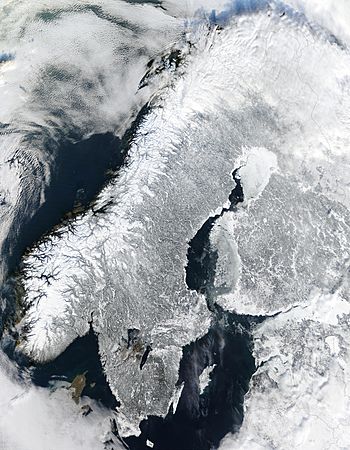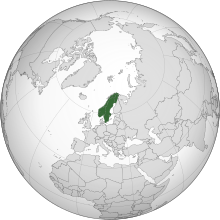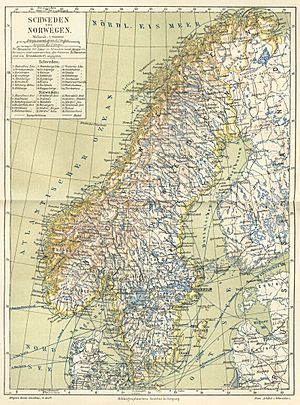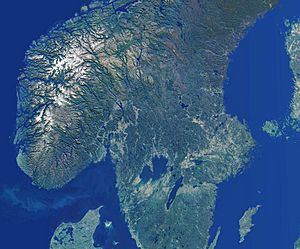Scandinavian Peninsula facts for kids

Scandinavian Peninsula in winter 2003
|
|
 |
|
| Geography | |
|---|---|
| Location | Northern Europe |
| Coordinates | 63°00′N 14°00′E / 63.000°N 14.000°E |
| Adjacent bodies of water | Arctic Sea, Atlantic Ocean |
| Area | 750,000 km2 (290,000 sq mi) |
| Highest elevation | 2,469 m (8,100 ft) |
| Highest point | Galdhøpiggen |
| Administration | |
| Mainland | |
| Mainland | |
| Parts of Lapland | |
The Scandinavian Peninsula is a large piece of land in Northern Europe. It includes most of Sweden and Norway, plus the northwestern part of Finland.
The name "Scandinavia" comes from a cultural area that includes Denmark, Norway, and Sweden. This cultural name itself comes from Scania, a region at the southern tip of the peninsula. Scania used to be part of Denmark and is the original home of the Danes. Now, it is part of Sweden.
The Scandinavian Peninsula is the biggest peninsula in Europe. It is larger than the Balkan, Iberian, and Italian peninsulas. During the last Ice Ages, the sea level dropped a lot. This made the Baltic Sea, the Gulf of Bothnia, and the Gulf of Finland disappear. Countries like Germany, Poland, the Baltic countries, and Scandinavia were all connected by land.
Contents

The Scandinavian Peninsula is Europe's largest peninsula. It is about 1,850 kilometers (1,150 miles) long. Its width changes, from about 370 to 805 kilometers (230 to 500 miles). The Scandinavian mountain range generally forms the border between Norway and Sweden.
The peninsula is surrounded by different bodies of water and countries:
- The Barents Sea is to the north.
- The Norwegian Sea is to the west.
- The North Sea is to the southwest.
- Russia, the Baltic Sea, and the Gulf of Bothnia are to the east.
- Denmark is to the south.
The highest point on the peninsula is Galdhøpiggen in Norway, which is 2,469 meters (8,099 feet) high. It also has the largest glacier on mainland Europe, called Jostedalsbreen.
About one-quarter of the Scandinavian Peninsula is north of the Arctic Circle. Its northernmost point is Cape Nordkyn in Norway.
The climate here changes a lot. In the north, it's very cold, like a tundra or subarctic area. Along the northwestern coast, it's cool and rainy. In the middle, it has cold winters and warm summers. The south and southwest have milder, rainy weather.
The region has many natural resources. There is a lot of timber (wood), iron, and copper. The best farmland is in southern Sweden. Large amounts of oil and natural gas have been found off Norway's coast in the North Sea and the Atlantic Ocean.
Most people on the Scandinavian Peninsula live in the southern part. This area also has the best farmland. The biggest cities are Stockholm (Sweden), Oslo (Norway), Gothenburg (Sweden), Malmö (Sweden), and Bergen (Norway).
The Scandinavian Peninsula sits on part of the Baltic Shield. This is a very old and strong part of the Earth's crust. It is made of ancient, hard rocks. During the Ice Ages, huge glaciers scraped away most of the soil from this rock. Because of this, and the cold climate, not much of the land is good for farming.
The glaciers also carved out deep river valleys. When the ice melted, the sea filled these valleys, creating the famous fjords of Norway. In the southern part of the peninsula, the glaciers left behind many piles of rocks and dirt called terminal moraines. These created a very bumpy landscape. These moraines also covered all of what is now Denmark.
Even though the Baltic Shield is very stable, the weight of nearly four kilometers (2.5 miles) of ice during the Ice Ages made the land sink. When the ice melted, the land started to rise again. This rising continues today, about one meter (3 feet) every 100 years. The southern part of the peninsula, however, has tended to sink a little to balance this out.
The hard rock and lack of soil in many places have revealed valuable mineral deposits. These include iron, copper, nickel, zinc, silver, and gold. The most important of these are the iron ore deposits in northwestern Sweden. In the 1800s, these deposits led to building a railway from northwestern Sweden to the Norwegian seaport of Narvik. This allowed the iron ore to be shipped to places like southern Sweden, Germany, Great Britain, and Belgium to be made into iron and steel. This railway is special because this part of Norway and Sweden usually has no railways due to its very rough mountains and fjords.
People and History of the Peninsula
The first signs of humans in the southern part of the peninsula and Denmark are from 12,000 years ago. As the ice melted, the climate became like a tundra, which attracted reindeer hunters. The climate slowly got warmer, allowing evergreen trees to grow, then deciduous forests. These forests brought animals like aurochs (a type of wild cattle). Groups of hunter-fisher-gatherers lived here from about 8200 BC, until farming began around 3200 BC.
The northern and central parts of the peninsula are partly home to the Sami. They are sometimes called "Lapps." They arrived thousands of years after the southern part of the peninsula was settled. In early times, they lived in the arctic and subarctic areas. They also lived in the central part of the peninsula, as far south as Dalarna, Sweden. The Sami speak the Sami language, which is not an Indo-European language. It belongs to the Uralic family, like Finnish and Estonian.
The first groups to live on the peninsula were the Norwegians on Norway's west coast. The Danes lived in what is now southern and western Sweden and southeastern Norway. The Svear lived around Mälaren and along much of Sweden's eastern coast. The Geats lived in Västergötland and Östergötland. These groups spoke similar dialects of an Indo-European language called Old Norse. Even though country borders have changed, the descendants of these people are still the main populations on the peninsula today.
Political Changes Over Time

The Nordic countries have a history of more than 1,000 years as separate areas. However, their international borders were set much later and slowly. It wasn't until the mid-1600s that Sweden had a clear path to the Kattegat sea and controlled the southern Baltic coast. The borders between Sweden and Norway were finally agreed upon and marked in 1751. The border between Finland and Norway on the peninsula was set after many talks in 1809. The shared areas between Norway and Russia were not divided until 1826. Even then, borders could still change. For example, Finland gained access to the Barents Sea in 1920 but gave this land to the Soviet Union in 1944.
For centuries, Denmark, Sweden, and the Russian Empire were the main powers on the Scandinavian Peninsula. Iceland, Finland, and Norway only became fully independent in the 20th century. The Kingdom of Norway was linked to Denmark for a long time. After the Napoleonic Wars, Norway became part of Sweden. It gained full independence in 1905. Finland had been an independent grand duchy within the Russian Empire since 1809. It declared independence during the Soviet revolution in Russia in 1917. Iceland declared its independence from Denmark in 1944, while Denmark was occupied by Nazi Germany. British and American forces, who were protecting Iceland from Nazi invasion, encouraged this.
The German Army invaded Norway in 1940 and occupied it until May 1945. With Sweden's agreement, German troops moved from northern Norway, through northern Sweden, into Finland. Finland had become an ally of Nazi Germany. Then, in the spring of 1941, the German Army and the Finnish Army invaded the Soviet Union together. Finland had a reason to be upset with the Soviet Union. The Red Army had invaded southeastern Finland in the Winter War (1939–40) and taken a large area of land from Finland.
Sweden remained a neutral country during the First World War, the Korean War, and the Cold War.
In 1945, Norway, Denmark, and Iceland were among the first countries to join the United Nations. Sweden joined soon after. Finland joined in the 1950s. The first Secretary General of the United Nations, Trygve Lie, was from Norway. The second Secretary General, Dag Hammarskjöld, was from Sweden. This shows that people from the Scandinavian Peninsula had a big impact on world affairs in the 20th century.
In 1949, Norway, Denmark, and Iceland became founding members of the North Atlantic Treaty Organisation. This was for their defense against East Germany, the Soviet Union, and other possible invaders. These three countries are still members today.
Sweden and Finland joined the European Union in 1995. However, Norway chose to remain outside the Union.
See also
 In Spanish: Península escandinava para niños
In Spanish: Península escandinava para niños
- Fennoscandia
- Baltoscandia



